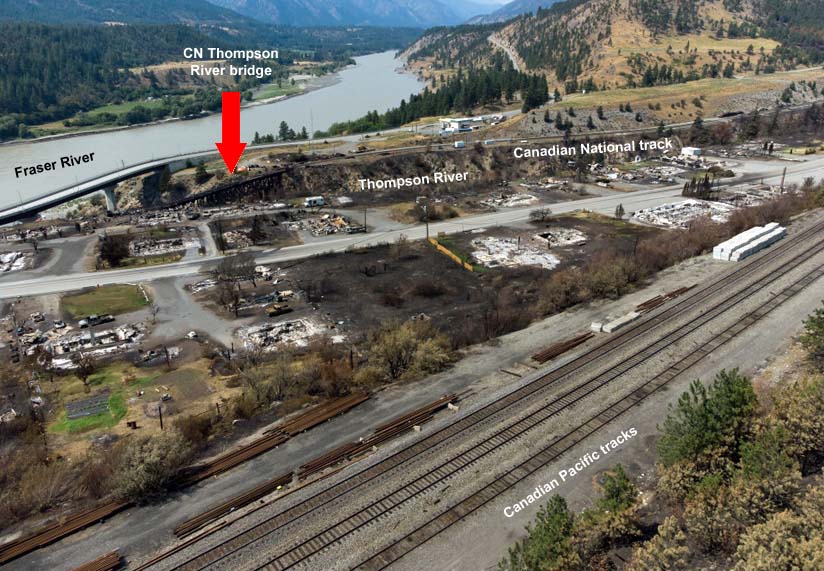

Lytton British Columbia - The cause of the wildfire in Lytton is now under investigation.
RT&S last week reported on the devastating wildfire that destroyed the town of Lytton along with infrastructure of both Canadian Pacific (CP) and Canadian
National (CN) railways.
The cause of the fire has not been reported.
The Vancouver Sun is reporting that Canada's Transportation Safety Board (TSB) has received information from the RCMP and B.C. Wildfire services that a freight
train may have been the source of the fire, and has begun an investigation into the situation.
Some residents of Lytton reported seeing a wheel on a freight train shooting sparks as it went by, but neither CN or CP have reported this.
And, the TSB does not know which company's train was generating the reported wheel sparks.
CN said the fire was not caused by any of its trains.
Marc Miller, the Indigenous Services Minister, said, "At this critical juncture, it is imperative that we all listen to the voices of Indigenous leaders
and engage meaningfully on a path forward that respects their needs and priorities, while ensuring rail safety and security."
Yesterday, Canada's Minister of Transport issued a statement requiring CP and CN to employ precautionary measures around wildfires.
The statement is reproduced in part below:
"An unprecedented wildfire has displaced hundreds of people in Lytton, the Lytton First Nation, and the surrounding areas.
Extreme weather and wildfire risk continues to pose an acute danger in British Columbia, as well as other parts of Canada.
Therefore, the Minister of Transport, the Honourable Omar Alghabra, today announced a Ministerial Order to immediately enact precautionary safety measures to
further protect against wildfires in the context of extreme weather conditions.
The Ministerial Order, in effect as of midnight PDT, 10 Jul 2021, requires the following:
Operations Between Kamloops and Boston Bar or Between Kamloops and North Bend on the Thompson and Ashcroft Subdivisions
"From the date of the issuance of this Order until 31 Oct 2021 when operating when the fire danger level in the area of the Subdivisions is
"extreme", CN and CP must:
- Incorporate the deployment of fire suppression capacity into their operations that will ensure a 60 minute response time to any fires detected along the
right-of-way of the Subdivisions in order to take steps to extinguish or control the reported fire, or to notify the fire service responsible for the area
if the fire cannot be controlled without assistance;
- Require that the conductor on any train be responsible for spotting for fires and reporting any fires or smoldering areas along the Subdivisions to Rail
Traffic Control for response by fire services;
- Ensure that any vegetation control measures are followed by removal of combustible materials;
- CN and CP must ensure that at least 10 fire detection patrols are conducted on the Subdivisions every 24 hours unless a train has not operated on the
relevant Subdivision for a period of at least 3 hours;
- "CN and CP must consult with indigenous governments or other indigenous governing bodies located along the Subdivisions to incorporate considerations of indigenous knowledge related to the presence of fire hazards, fire risk, and control of fires into the preparation of Fire Hazard Reduction Plans, and the Fire Preparedness Plans required under the Prevention and Control of Fires on Line Works Regulations.
Extreme Weather Fire Risk Mitigation Throughout Canada
- "Where the air temperature is 30 to 32 degrees Celsius, and the fire danger level for the area is "extreme", Class 1 railways must ensure
train speeds are reduced to 25 mph where permitted track speed is between 26 mph and 35 mph and by 10 mph if track speed is 36 mph or
greater;
- Where the air temperature is 33 degrees Celsius or higher and the fire danger level for the area is "extreme", Class 1 railways must ensure
train speeds are reduced to 25 mph where permitted track speed between 26 mph and 50 mph and to 30 mph where the permitted track speed is 51 mph or
greater;
- From the date of issuance of this Order until 31 Oct 2021 Class 1 railways must ensure that no locomotive is operated through an area where the fire
danger level is "extreme" unless it has been inspected in the previous 15 days to ensure the locomotive's exhaust passages are clear of
combustible material, including oil accumulation and carbonaceous deposits in excess of 1/8 inch (3 mm) in thickness;
- Class 1 railways must develop and implement an Interim Extreme Weather Fire Risk Mitigation Plan within 14 days following the issuance of this Order that
at a minimum addresses fire detection, monitoring, and response measures;
- Class 1 railways must communicate the Interim Extreme Weather Fire Risk Mitigation Plan to municipal and other orders of government, including Indigenous
governments or other Indigenous governing bodies, and establish a method for receiving comments for consideration;
- Class 1 railways must complete and implement a final Extreme Weather Fire Risk Mitigation Plan within 60 days following the issuance of this Order.
"With extreme weather events occurring more severely and frequently in Canada due to climate change, it is important to have an adaptive regulatory
system that responds to these new risks.
This Ministerial Order will put in place interim measures while the department works with railway companies to incorporate these fire risk reduction measures
on a permanent basis into the existing regulatory framework for railway operations in Canada."
David C. Lester.
(because there was no image with original article)
(usually because it's been seen before)
provisions in Section 29 of the Canadian
Copyright Modernization Act.
